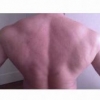Les préconisations de Mike Arnold (Steroid Injection Guide) : VI. What kind of syringe should I use? [...] “Standard Needle Lengths for Injection” Glutes: 1-1.5 inch. Delts: 1 inch. Quads: 1 inch (some individuals can use as small as a ½ inch needle when injecting into the quads, depending on how lean they are). Biceps: ½-1 inch. Triceps: ½-1 inch. Calves: ½ inch. Traps: ½- 1 inch Lats: 1 inch. The above recommendations are the “average” needle lengths used for each bodypart listed. 23-25 g. syringes can be purchased with needle lengths between ½ to 1.5 inches in length. Simply choose whatever needle length you will need based on the bodypart(s) you will be injecting into. “CC’s & ML’s” The term “cc” stands for cubic centimeters and is a unit of measurement for determining injection volume. It is important to note that the term “cc” and “ml” (milliliter) are identical and interchangeable with each other. 1 cc= 1 ml. While syringes will indicate measurement in cc’s, steroid products (vials/bottles/ampules) will almost always use ml’s as their unit of measurement. So, if your steroid product says it contains 10 ml per bottle at 250 mg/ml, you know it also contains 10 cc’s per bottle at 250 mg/cc. Therefore, if you wanted to inject 500 mg of that steroid, you would need to inject 2cc’s (2 ml’s) of that product. Most 23-25 g. syringes hold 3 cc’s, although some will occasionally hold less, so you when ordering you should always specify exactly what you want to purchase. Since 3 cc syringes are no more costly than their smaller counterparts and being that many steroid users will often inject more than 1 cc at a time, it makes sense to strictly purchase 3 cc syringes for steroid injections. Note on water-based injectables: Fewer and fewer steroids today use water as a carrier, due to water’s greater propensity to form bacteria compared to oil-based steroids. Still, water-based injectables make up a small segment of the market, primarily in the form of various brands of Testosterone suspension and injectable Winstrol preparations. While the variables of needle length and “cc” count transfer over from oil-based to water-based injectables, gauge number can be all over the place depending on brand. Fortunately, most manufacturers today are moving towards ultra-micronized versions of these products. When a water-based product is ultra-micronized, it means that the steroid particles within the water are very fine and can through a higher gauge number. Products which are not ultra-micronized contain particles which are much thicker and therefore, they require a lower gauge number in order for the particles to fit through the needle. Suspension products can require a gauge size which ranges anywhere from 18 g. (typically with very crude, older products; these don’t exist much today) to 25 g. or above. VII. Where do I inject? Inevitably, one of the first questions many individuals will ask themselves shortly before their 1st injection is “where do I inject?” While there is no right or wrong answer, the most commonly injected muscles among first time users are the glutes and delts. Both muscle groups are relatively painless (potentially), do not have any major veins/arteries near the surface, and contain a lower density of nerves. Quads are another popular bodypart used for injections, although one does need to be a bit more careful when injecting in this area, as there are more nerves, veins, an arteries in the area. Basically, any muscle can be injected into, although larger, thicker muscles are typically superior to small, shallow muscle groups. An example of a bodypart which falls into the latter category would be the forearms. This body part is rarely ever injected into and is a poor choice all the way around, so avoid them. Never inject into the hands, feet, or neck Just as important as what muscle you decide to inject into is the location chosen within that muscle. In general, when deciding where to place your injection, gravitate towards the thickest, meatiest part of the target muscle. However, this advice will not always lead you in the right direction, so here are some basic pointers for the most common muscle groups (delts, glutes, and quads). When injecting into the delts, all 3 heads are suitable, although the side & rear heads are a bit more comfortable, on average. Injecting anywhere on the glutes is fine, but avoid injecting too far out to the side of the glutes, as the sciatic nerve (a major nerve which runs all the way down the glute and leg) resides in that area. When injecting into the quads it is a bit trickier. Never inject into the inner-thighs…only inject into the actual quadriceps muscles themselves, particularly the vastus lateralis, and rectus femoris. The vastus medialis (teardrop) can also be injected into, although it is not a preferred area for a beginner. As you advance you will develop your own preferences regarding injection site selection and VIII. How many cc’s can I inject into each muscle at one time? Primary injection sites Glutes: 3 cc limit Delts: 2 cc limit (3 cc’s is doable in the delts if using a 1 inch needle, but it’s preferable to use the quads or glutes for injection volumes above 2 cc’s). Quads: 3 cc limit (when injecting more than 2 cc’s into the quads, you should use a 1 inch needle. With injection volumes under 2 cc’s, a ½ inch needle is fine, assuming you are lean). Secondary injection sites Biceps: 1.5 cc limit. Triceps: 1.5 cc limit. Calves: 1.5 cc limit. Traps: 2 cc limit. Lats: 2 cc’s. It is recommended that beginner’s stick with the primary injection sites until technique is developed and the user becomes proficient at the injection process. Secondary injection sites have a higher margin of error (more nerves, more blood vessels, and sometimes smaller muscle bellies) and can be more painful, as well. Often times, advanced users will begin utilizing these secondary injection sites due to a frequent Injection schedule and/or because they have previously administered a large amount of injections into the primary injection sites. Frequently injecting into the same area(s) and/or having administered a large total number of injections into the same area(s) can cause excess scar tissue build-up. IX. Rotating injection sites One issue which may eventually arise if the individual continues injecting AAS long enough is the issue of scar tissue build-up. Scar tissue is a dense, fibrous, connective tissue which forms over a wound or cut, either external or internal. In the case of injection, the scar tissue formed is internal. Scar tissue can impede contraction (make the muscle weaker), impair local muscle growth, decrease flexibility, and increase the possibility of re-injury. Some scar tissue formation is unavoidable, as every time an injection is administered, scar tissue is formed. The bottom line is that excess & problematic scar tissue is not something you want to have to deal with at any point. Fortunately, we can take steps to minimize the appearance of scar tissue through rotating injection sites. Scar tissue is much more likely to form to a greater degree if you repeatedly and frequently use the same injection site. For this reason, it is a good idea to start a “rotation”, in which injections sites are routinely transferred from one site to the next in a systematic fashion. Typically, the individual will select at least 3 body parts to include in this rotation, while also altering the sites within each bodypart, in order to decrease the number of times the same area is injected into per rotation. The following is an example of an effective injection site rotation: Injection #1: Upper-left glute Injection #2: Upper-right glute Injection #3: Upper-right delt Injection #4: Upper-left delt Injection#5: Upper-right quad Injection #6: Upper-left quad. Injection #7: Lower-right glute. Injection #8: Lower-left glute. Injection #9: Lower-right delt. Injection #10: Lower-left delt. Injection#11: Lower-right quad. Injection #12: lower-left quad. Injection #13: Repeat. This particular 12-site rotation utilizes several of the most common & safest injection sites. This is just one example of how you might want to structure you injection rotation, depending on personal preference. The number of potential injection sites is extremely large, as even small needle placement adjustments are effective for minimizing excess scar tissue build-up. The type pattern followed is not what’s important. What matters is that you change your injection sites frequently. En résumé ( http://www.spotinjections.com) : *When beginning, limit injections to 3 CC's at a time for glutes, 2 CC's for thighs and 1 - 1.5 CC's for all other spot injections *Rotate injection spots. This will keep your receptors fresh. So right glute, right delt, right leg, left leg, left delt left glute - this will give you ample time off in between. Make sure you dont hit an injection spot more than once per wk - you are using 6 sites so you should be fine



